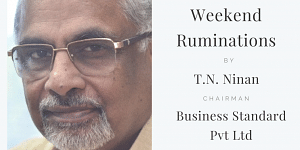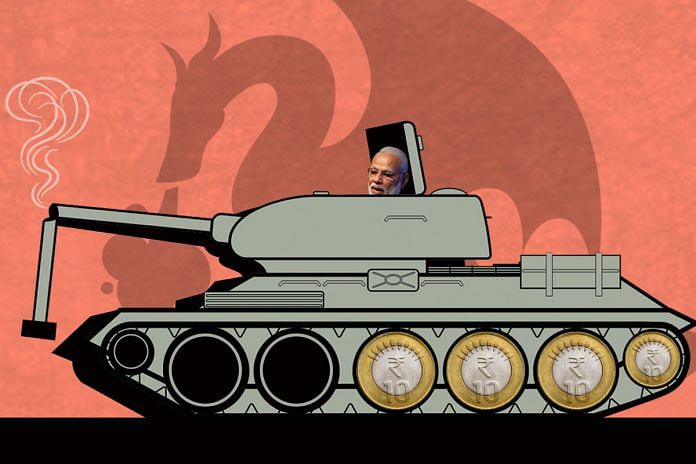The defence squeeze is particularly difficult to understand because the BJP has traditionally been more security-oriented than other political parties.
One of the abiding mysteries about the Narendra Modi government is the way in which it has ignored the emerging contours of the country’s external security situation, and squeezed the defence budget year after year. The Budget for next year continues in the same vein, with the allocation for defence going up by less than 6 per cent, about the same as for the current year. Over the five Budgets that cover the full span of the Modi government, the defence budget will have gone up by just 38 per cent, which works out to an average of less than 7 per cent a year.
This barely keeps pace with inflation. Since there have been large increases in pay because of the Pay Commission, the capital budget available for buying weapons has shrunk in real terms. As a share of the GDP, defence expenditure is down to 1.5 per cent, from 1.8 per cent in the terminal year of the last government. These numbers exclude defence pensions, which add a staggering 0.6 per cent of GDP, and are more than the defence capital budget, thanks in part to the indefensible decision on ‘one rank-one pension’.
 Specialists in the field say the non-pension component is the lowest since the traumatic 1962 border war with China. Maintaining the outlay at 1.8 per cent of GDP would have given defence an additional Rs 500 billion next year and perhaps a cumulative total of Rs 1.5 trillion over all five years. That money would have come in very handy for acquiring war equipment that the forces badly need: 10 squadrons of fighter aircraft, hundreds of helicopters, half a dozen submarines, minesweepers, missiles, howitzers, etc.
Specialists in the field say the non-pension component is the lowest since the traumatic 1962 border war with China. Maintaining the outlay at 1.8 per cent of GDP would have given defence an additional Rs 500 billion next year and perhaps a cumulative total of Rs 1.5 trillion over all five years. That money would have come in very handy for acquiring war equipment that the forces badly need: 10 squadrons of fighter aircraft, hundreds of helicopters, half a dozen submarines, minesweepers, missiles, howitzers, etc.
The defence squeeze is particularly difficult to understand because the Bharatiya Janata Party has traditionally been more security-oriented than other political parties. From its inception, it was in favour of the country going nuclear; retired service officers join its ranks, and some have become ministers in the government. For good measure, the finance minister has twice held defence as an additional portfolio. Yet, defence has got Cinderella treatment when it comes to financial allocations.
The context is important. The country faces a noticeably more aggressive China on its northern border. The military advantage vis-a-vis Pakistan has been eroding. The air force began looking for new combat aircraft to replace the MiG-21 nearly two decades ago, and is yet to get the first plane. The Chinese navy, whose first ship entered the Indian Ocean less than 10 years ago, now has a minimum of eight ships in the Ocean at any point of time, with the number going up to 14 on occasion — as the naval chief has said publicly. China is also acquiring naval bases on the fringes of the Indian Ocean. During the last decade, the number of Indian naval ships has remained virtually unchanged — with all the newly commissioned ones handicapped by the lack of critical equipment. At this rate the traditional naval assumption that it could squeeze Chinese shipping at the choke point of the Malacca straits, thereby posing a deterrent to Beijing, may no longer be valid.
The only credible explanation for the niggardly approach to defence expenditure must be that the government does not expect a war, and therefore has chosen to give priority to spending on infrastructure and other civilian needs. But wars can happen when you don’t expect them, and re-arming at the last minute is not possible. Readers will recall that, after the terrorist attack on Parliament in 2001, and later, the one in Mumbai in 2008, the forces were not able to offer military options to the political leadership. Operation Parakram, for instance, ended in a pointless stand-off at the border. If there were to be a repeat situation today, the story would probably be no different. The question is whether the country should worry about this situation, and whether the government should take a fresh look at the size of the defence budget.
By special arrangement with Business Standard




I do believe all of the ideas you’ve offered to your post.
They are very convincing and can definitely work.
Still, the posts are very short for beginners. Could you please prolong
them a bit from next time? Thanks for the post.
It’s appropriate time to make some plans for the future and it
is time to be happy. I’ve read this post and if I could I want to suggest
you few interesting things or suggestions. Maybe you can write next articles referring to this article.
I want to read even more things about it!
This is a comment to the Why has the BJP given defence the Cinderella treatment in its Budgets? webmaster. Your website is missing out on at least 300 visitors per day. Our traffic system will dramatically increase your traffic to your site: http://xahl.de/p – We offer 500 free targeted visitors during our free trial period and we offer up to 30,000 targeted visitors per month. Hope this helps 🙂 Unsubscribe here: http://xahl.de/q
The elected govt whoever is in power ignore the armed forces and treats it like pariah. Use and throw policy….The Nehru’s and Gandhi’s were worried that they would be lynched by army as paki army did to Bhutto and hence reduced it’s power. Modi govt is no different, just talking about robust approach on border without giving the necessary fire power and ammunition to armed forces is just bluffing and this bluff would be called by enemies which are on western and eastern/northeast borders.
The best replacement of Mig21 and Mig27 is Tejas.
After demonetization to shore up bankrupted PSU banks and crony capitalists, the economy has taken a major hit. Fact is, India has no money for defense after demonetization and OROP. The pension bill of the armed forces is more than twice the combined budget of navy and air force.
We have to trim the size of our 1.2 million army and 1.3 million paramilitary troops. What is the need of such huge army if the borders are being defended by ITBP, BSF, SSB etc? We either need to send the army to the border or cut its size drastically.
Nitin Gadkari had given the perfect reply to Navy when they wanted more land in South Mumbai.
Yes Mr Naveen, we do not need defense forces, we have our babus and politicians, disband the defense forces, we have pakistan and china who can be our masters and we can serve them with wagging tails. we will save lot money for new masters by saving from defense budget
We should always add the cost of pensions to the defence budget. It is an integral part of our security expenditure, has crossed one trillion, and, with longevity and OROP, will keep growing.
Because there is no money. 2. If one may reverse the proposition, the availability of resources should be an important input to the security posture. With nuclear deterrence in place, India does not face an existential threat from either adversary. Whether we should talk to Pakistan is a political judgment. The daily shelling along the LoC is simply a reminder of the futility of the standoff, as Siachen is. 3. China is the more important issue to be addressed. With or without the quad, the dragon is now on an orbit far above ours. India cannot afford an arms race with it, any more than the Soviet Union could with the United States. If a more constructive engagement with China, including participation in OBOR, can create resources for infrastructure, that option should be considered. 4. India’s foremost strategic objective is not to become a global power, with a blue water navy and a permanent seat on the UNSC. It is to end the scourge of mass poverty, our stunted children, poor education and healthcare, the restlesd young without jobs.